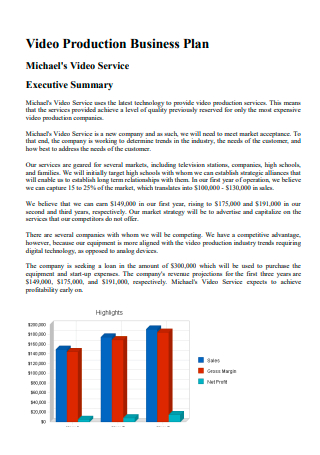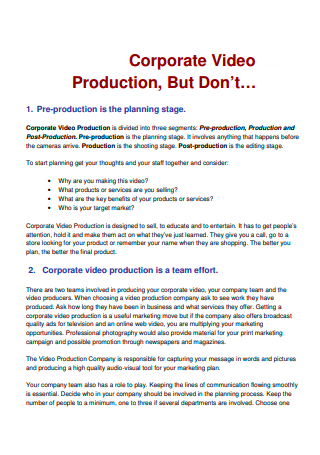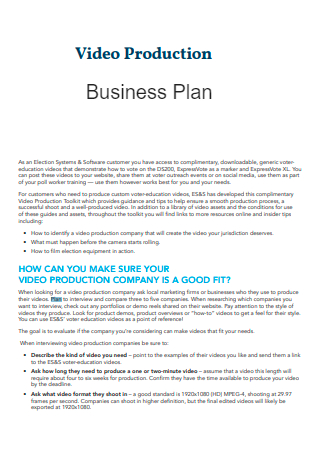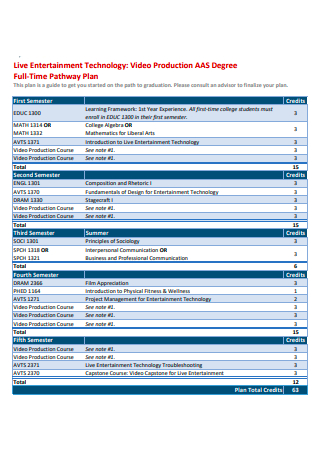4+ Sample Video Production Business Plan
FREE Video Production Business Plan s to Download
4+ Sample Video Production Business Plan
What Is a Video Production Business Plan?
What Is a Video Production?
What Is a Video Producer?
What Are the Phases of Video Production?
What Are the Types of Video Production?
How Do You Write a Video Production Business Plan?
FAQs
How much does it cost to start a video production business?
How much does a 3-minute video cost?
Who is your audience?
What Is a Video Production Business Plan?
A video production business plan is a vital component for the success of a business. It is not just a document for investors and stakeholders—it also helps the entrepreneur to get a better understanding of what their business demands.
This business plan acts as a guide in successfully building a business model. Making a video production business plan communicates to the business stakeholders that you have a plan in place.
What Is a Video Production?
Video production captures the images through a tape or memory card. This medium is so handy that many argues that video production proposal is the typical tool to accomplish any kind of storytelling. Moreover, video is one of the most successful forms of media used today to engage, inspire, or educate people and this production allows you to fully engage a particular audience and take them on a journey with the help of creative and technical manipulation by combining both visual schedule and audio elements. With video production, every detail from the creative concept to the execution is usually meticulously spelled out, sometimes with detailed scripts, storyboards, and scenes.
In addition, video production is the overall process carried out by a crew of professionals who collaborate to capture, process and edit images for the finished video.
What Is a Video Producer?
A video producer manages and coordinates many aspects of a video production process from start to finish. To put it in detail, a producer may help with creative direction, writing scripts, setting a budget, organizing logistics, deadlines, and communicating with the team each step of the way.
Additionally, throughout the entire video production process, a video producer is in persistent communication with their team, the client, and various other members of a video shoot. Working to help creatively execute something as unique and subjective as a video proposal project needs a lot of trust, communication, and expectation setting.
What Are the Phases of Video Production?
Each step in the video production process must be wisely planned and executed to make a short story or message come to reality. Video production is a balancing act. Here are the phases of video production scope of work:
Stage 1: Strategy. The first thing to look at is the overall smart goal of the video before starting any video production. The big-picture goal will drive your decision-making. Before planning the next phases, take into account factors like the video’s smaller goals, where the video will live, the target demographic, your budget, and what metrics will be used to track the video’s reach and response.
Stage 2: Pre-production. Pre-production comprises all of the creative and strategic planning needed to move ahead with production—like ideation, mood boards, concept creation, style guides, actor casting, props, script writing, sourcing locations, and scheduling. Detailed and accurate budgeting is key in this phase to make sure that you have the resources you need to make your story come to life and that you get your money’s worth from all of the vendors involved. Pre-production is often the most time-consuming part of a video production, but it’s also one of the most important phases, effectively setting the tone for a successful video production. A poorly-planned video can fall apart and cost a lot of time and money for everyone involved without thoroughness during Pre-production.
Stage 3: Production. The Production phase could last a few days or a few hours as the several departments of directing, camera, lighting, art and more work in interdependence to achieve the video goals depending on the size of the production. Production is the spot where the magic happens, where the actors deliver their lines, background ideas become scenery and a script comes to life with the camera rolling. Depending on the concept, production may take place in a studio or on-location for a more lifestyle-driven shoot. For on-location shoots, besides renting the property itself, there might be other things to do such as securing filming permits, hiring police/security, and getting the owners to sign legal location releases.
Stage 4: Post-production. Post-production is naturally the second-longest phase as there are often multiple partners who will need to review and approve edits, revisions, and final cuts. Post-production can comprise everything that happens after the production, and usually involves applying computer editing and graphics skills. Behind the scenes, assistant editors will organize the footage, sync the audio, and get everything named and ready for the lead editor to get to work. Moreover, lead and assistant editors will then assemble what is called a story cut. If anything is missing, it is the time to schedule a reshoot to get it right. In addition, for the working version of the video, the editors will apply a mastering process that is done to both visuals (color correction) and audio (audio mastering). Lastly, make sure to keep things organized and stick to the schedule to assure the video is delivered on time and within budget.
Stage 5: Distribution. A production that is properly distributed can be a big factor in its success. This can include things as simple as posting the video on a website or on YouTube, or negotiating media buys to get television views, going a step further to turn the video into Facebook ad, or placing it on in-store video displays. TV is the old-style medium place to be seen and still one of the most operative ways to get video content out to the masses. But with the growth of online video views via social media sites, more brands and businesses are converging on videos that live online where their customer and potential customers are spending their time.
What Are the Types of Video Production?
How Do You Write a Video Production Business Plan?
Step 1: Short and detailed executive summary
This is the summary of the whole document. You should capture all the essential information while writing the executive summary. Exactly define the business objective through the company statement. Take in the product and services you are offering as well as the marketing plan.
Step 2: The business idea should be direct
Video production is a broad category and you need to narrow it down further. The objective is to keep the description simple and clear. You also need to explain the general status of the business, is the business a start-up, or is it a continuing business that you need to expand. Evidently, describe the type of business you plan on managing. You should state whether it is a sole proprietorship, a partnership or a limited liability.
Step 3: On product and services
Since you are in the video production industry, explain the unique features of the products you are using, such as the cameras and others. Outline the technological advancement of the products as well as the processes but don’t dwell so much on it. Focus on how you are going to position yourself in the industry and gain a competitive advantage over your competitors.
Step 4: Strong marketing strategy
Existing businesses that are drawing a business plan for expansion rely on past data for their market analysis. The market analysis of your business is based on the information about your target market and customer demographics. Analyze the customer base, prospects, and market share.
Step 5: Define your business location
You don’t want to spend much of your finances on advertising so, it is important that you establish your video production company in a place where you can easily attract customers. For instance, if you specialize in events videography, then you locating your business near event planners contract and event shops is a good strategy.
Step 6: Know your competitors
Any business idea with a high market potential has competitors. Broaden your concept of the competition and make a list of your top competitors. Critically analyze the strategies used by your competitors as well as the expected reaction of your competitors when you enter the market.
Step 7: Describe employee qualifications
Recruiting and keeping the best and qualified employees are challenging for almost all business. The success of your company will depend on your ability to recruit, train and keep honest employees. Your video production business plan should put more emphasis on the skills of your employees, the staffing compensation plan, availability, and their future needs
Step 8: Provide a credible investment plan
Regardless of whether the business is a start-up or an already existing venture, the investment section is critical. The primary concern should be on detailing how you are going to utilize the funds and what is going to be the return on investment known be accounting professional as return of investment.
Step 9: Consider your finances
You will require funds for purchasing your video production equipment. You might also need to set aside money for rental space. Consider the following:
- Create projections on how you are planning on making profits, e.g. through video production and editing.
- You should also include a plan on how you will repay your existing debts.
- Identify the number of projects you anticipate to work on within a given period.
- Under projected financial statements-demonstrate, how the business is going to generate operating cash flow as well as profitability.
FAQs
How much does it cost to start a video production business?
Video producers often have two to three cameras, wireless microphones, a basic lighting set, computer editing bay with Final Cut or Adobe Premier and various lenses for the cameras. Purchase your equipment. Depending on the quality of equipment, a video production business should expect to spend at least $15,000 for a full setup with costs going into the hundreds of thousands for high-end equipment.
How much does a 3-minute video cost?
It is hard to say but a good rule of thumb is to estimate $1500 to $10,000 per finished minute for an average production. It is safe to assume a rate of about $3,000 to $5000 on average per finished minute of video if you average this rate out.
Who is your audience?
Most people who attend fundraisers know that they will be asked for donations, but they are much more likely to donate if they are feeling emotionally compelled after watching a story that demonstrates their impact. This goes for all videos, even outside of the fundraising space. You want your video to resound with your intended audience. Can your client describe in detail who the audience is and what they care about? This can be essential to the success or failure of your video.
Video producers are an essential part of any video shoot. They help manage all of the details in the process to make sure that everything goes smoothly and you walk away with a finished product that exceeds your expectations.
A professionally created video production business plan will help your firm reach its full potential. Knowing who your competitors are will allow you to structure your business according to the needs of the market.
The goal is to make sure the video process goes as smooth as possible. Having the necessary information and good communication will bring you the best video product your team can offer.





